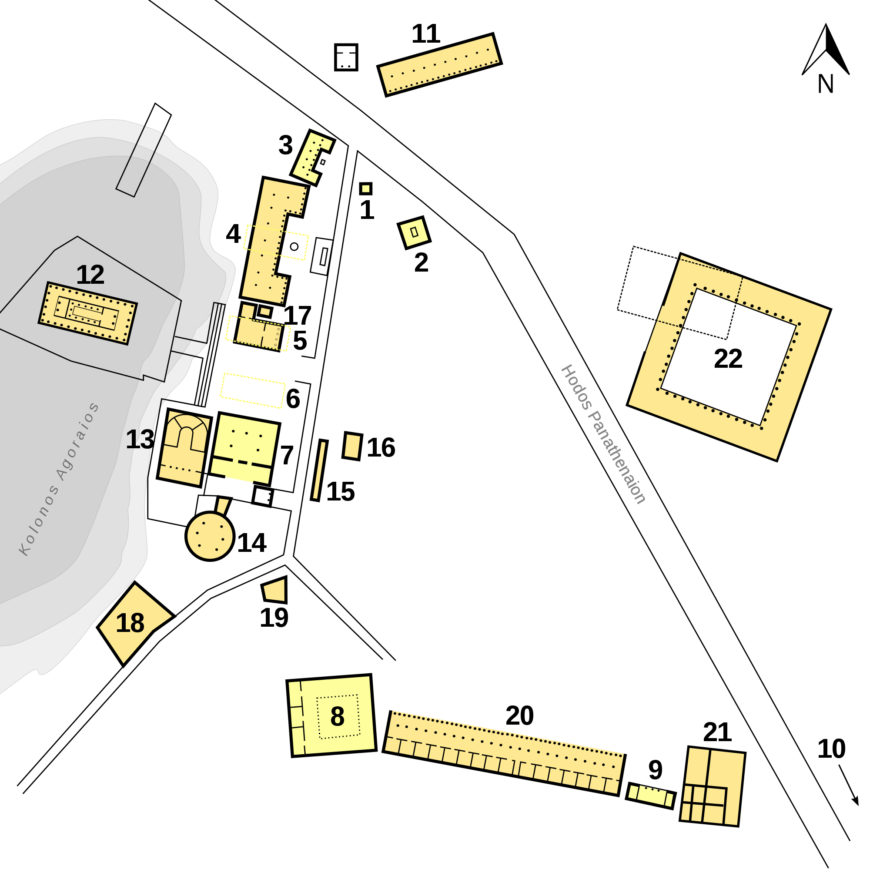We recognize ancient Greece as the birthplace of democracy, but what did democracy really mean to the Greeks?

Site plan of the Agora of Athens in the Classical period, creator: Tomisti, CC BY-SA 4.0
- Leokoreion
- Altar of Twelve Gods
- Royal Stoa (Stoa Basileios)
- Temple of Zeus, later Stoa of Zeus
- Old and new Temple of Apollo Patroos
- Old Metroon
- Bouleuterion
- Aiakeion (not Heliaia as previously thought)
- SE fount (often Enneakrunos)
- Eleusinion (outside the map)
- Stoa Poikile
- Temple of Hephaestus
- New Bouleuterion
- Prytanikon, later Tholos
- Monument of Eponymous Heros
- Altar of Zeus Agoraios
- Temple of Zeus Phratrios and Athene Phratria
- Strategeion
- House of Simon & agora boundary stone
- South Stoa I
- Mint
- Columned court
Additional resource
Athenian Agora Excavations by the American School of Classical Studies at Athens with resources on the history of excavations and democracy, guide to the site, research, and publications
Smarthistory images for teaching and learning:
[flickr_tags user_id=”82032880@N00″ tags=”agora,”]
[0:00] [music]
Dr. Beth Harris: [0:04] We’re overlooking the Agora, the most important public space in Athens in the 5th century B.C.E.
Dr. Steven Zucker: [0:11] It’s up the Sacred Way, at the top of the Acropolis where the sacred sites of Athens [are]. Here, at the base, was the place of public discourse, the heart of the Athenian experiment in democracy.
Dr. Harris: [0:23] In the 5th century [B.C.E.], we see this opening up of the ability of the citizenry to participate in the government. Athens was not the kind of democracy that we think of in the West. The citizens of Athens didn’t vote for the representatives in the government, but participated directly.
[0:38] With an election, anyone who’s a great speaker or someone who’s particularly wealthy could become politically powerful, and so offices were held by rotation instead of by election.
Dr. Zucker: [0:50] There were [a] few positions that were voted on, and those were positions where particular skills were required. For instance, Pericles was re-elected to be the general some 15 times.
Dr. Harris: [1:01] He was essentially the leader or the president of Athens during about a 30-year period. It’s important to remember what we mean by the ideas of democracy that were started and formulated here.
Dr. Zucker: [1:12] Well, they were extremely limited. In order to be able to take part in public life, to take part in governmental decision-making, you had to be a citizen. In order to be a citizen, you had to be male and you had to be Athenian. In fact, Pericles, the great Athenian general, would tighten up the rules, so both of your parents had to be Athenian in order for you to be able to participate.
Dr. Harris: [1:33] Right inside the museum, we can see examples of democracy in action. There are primitive machines for choosing who would sit on the juries.
Dr. Zucker: [1:43] We also see inscriptions in small pieces of pottery that were used to vote to ostracize public leaders that were seen to have become corrupt.
Dr. Harris: [1:51] And so, if one citizen was seen to be usurping power, the citizens could vote to ostracize him, and he would have to actually leave Athens. This is a good reminder that there were a lot of checks in place against any one person assuming too much political power.
Dr. Zucker: [2:07] Importantly, it was during the 5th century [B.C.E.] that the philosophy behind democratic rule was set forth. Probably the most famous expression of that was written by the historian Thucydides, who chronicled the Peloponnesian War, that is, the war between the Athenians and the Spartans.
[2:23] Thucydides recounts in his history a funeral oration Pericles gave during the early stages of the war with Sparta.
Dr. Harris: [2:32] “If we look to our laws, they afford equal justice to all in their private differences. If to social standing advancement in public life falls to reputation for capacity, class considerations not being allowed to interfere with merit. Nor again does poverty bar the way. If a man is able to serve the state, he is not hindered by the obscurity of his condition.”
Dr. Zucker: [2:54] What Pericles by way of Thucydides is laying out here is this notion of a meritocracy, and that no able person’s ability is lost due to having been born without wealth.
Dr. Harris: [3:05] And the idea of equality before the law. These are fundamental principles to Western ideas of democracy. It’s no wonder that we look back to Athens in the 5th century B.C.E. and heroize it, maybe a bit too much sometimes.
Dr. Zucker: [3:19] Well, especially considering how fragile it was, and how limited it was, and how short-lived it was.
Dr. Harris: [3:25] This is a space that started out as a place for markets, as a place of buying and selling, and gradually during the Archaic and then the Classical period became a place of government, with administrative buildings and also some sacred spots as well, although the primary sacred spot was, of course, on the Acropolis.
Dr. Zucker: [3:41] We also have increasingly substantial structures built in the 5th century [B.C.E.] in the Agora, and one of the most important is called the Stoa. People would have conducted business here. Political discussions might have taken place here. All kinds of civic life.
[3:55] Once a year, a great procession would make its way through the Agora and up to the sacred mount.
Dr. Harris: [4:01] This is the main religious festival in Athens, dedicated to Athena, the goddess who was the protectress of the city. We can imagine, as we look over the Agora, a procession of Athenians making their way up to the Parthenon.
Dr. Zucker: [4:14] I love to look over the Agora, and to imagine the great philosopher Socrates walking through here, causing trouble, asking questions.
Dr. Harris: [4:22] Asking uncomfortable questions that would ultimately make him an enemy of the Athenian state.
Dr. Zucker: [4:27] And lead to his execution.
[4:28] [music]

